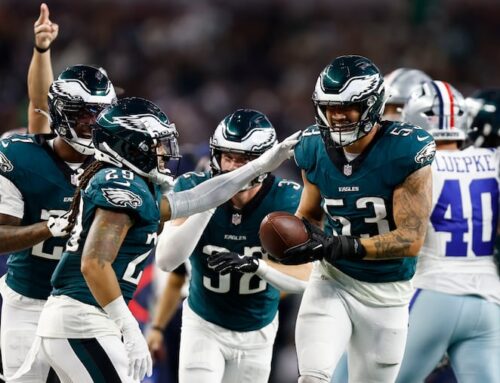Why Fox Keeps Investing in the Declining Business of Broadcast and Cable
May 12, 2025
The television industry in 2025 is often summed up by two major trends: People aren’t watching cable like they used to, and nearly every network is struggling to attract Gen Z and younger audiences. On both counts, Fox has emerged as the exception.
In the first quarter, Fox News delivered its highest-rated quarter in cable news history, securing an average of 2.2 million viewers a day from Monday to Friday. As for Tubi, Fox’s free-ad supported streaming offering, set a record earlier this year, delivering an audience of 13.6 million viewers during an average minute, so-called AMA, and making Super Bowl LIX the most-streamed game ever. Over half of the streamer’s viewers are Gen Z or millennials, and 65% are cord-cutters or cord-nevers, according to the November MRI Cord Evolution Study.
“With Fox, we have the largest live audiences in media, which means mass reach in sports, news and broadcast. Then on the Tubi side, we reach the one audience that is very challenging to reach with live,” Jeff Collins, president of advertising sales, marketing and brand partnerships for Fox Corporation, told TheWrap. “When you put the two of those things together, it’s a very complete offering. It’s not cannibalistic, it’s very complementary.”
Collins cited Fox’s continued investment in broadcast and cable as a major factor in its overall success. As most of the company’s competitors pulled back from these areas to focus on streaming, Fox continued to invest in broadcast and cable.
“We continued to invest in our linear networks, both on the news side as well as on the broadcast side by continually increasing our content investment spend, which has resulted in higher audiences and a higher ad spend,” Collins said. “It’s almost the opposite trend from what you’re seeing in cable now, which is less content investment. Lower content investment is leading to lower ratings, which is leading to less advertiser interests in those areas, and then it becomes sort of a self-fulfilling, vicious cycle.”
Ahead of Fox’s upfronts presentation, Collins spoke to TheWrap about how flipping this well-known television script has paid off for the company. The interview has been edited for length and clarity.
TheWrap: How are you thinking about the Trump administration’s tariffs? How are you adjusting your advertising and sales strategy during this unprecedented time?
Jeff Collins: We’re not seeing any material impact from the tariffs. At this point, we’re in constant dialogue with our clients and our advertisers, especially leading up to an upfront. So far, I’m encouraged from the messaging that I’m hearing coming from them. I think a lot of advertisers learned some important lessons during COVID, and certainly during COVID, we did see a bit of a flight to quality. Fox certainly benefited from that. As advertisers really focused on properties that were really best in class, that drove results. Also during COVID, one of the lessons that was learned was, “Don’t overreact too quickly” and “Don’t cancel and pull back too quickly or you risk losing market share.” We hear a lot from clients now that they don’t want to overreact or over-correct too quickly. They understand that, even with an upfront, they still have quite a bit of flexibility in the media with options around cancellation and confirmation dates.
Tubi just had a stellar year with the Super Bowl. How are you thinking about Tubi right now?
The strategy at Tubi is a little bit different than the strategy of some of our streaming competitors in that it’s really focused on a very different and incremental audience than our linear properties. It’s focused on cord-cutters and cord-nevers, a younger audience. If you take a look at the Super Bowl, 40% of the Super Bowl audience on TV was between the age of 18 to 34, so very young. Then 20% was female between the age of 18 and 34, so those are truly incremental audiences that are coming in and watching.
Tubi is really not meant simply to be a home for repurposed Fox content. It’s meant to truly be a home for its own original content with its own original strategy to target the next generation of viewers, and that’s why Tubi and Fox complement each other so well. With Fox, we have the largest live audiences in media, which means mass reach in sports, news and broadcast. Then on the Tubi side, we reach the one audience that is very challenging to reach with live. When you put the two of those things together, it’s a very complete offering. It’s not cannibalistic, it’s very complementary.

There have been many plays across the media ecosystem to try to get that younger audience, and Tubi seems to be one of the few that’s working. Why do you think that is?
Certainly not having a subscription gate helps. It’s very accessible, and it’s accessible to that cord-cutter and cord-never audience that may have a bit of subscription fatigue. Also, Tubi’s done an amazing job building communities around content, particularly content that engages younger audiences.
Typically, broadcasters and news channels benefit from a big boost in advertising during election years. Do you feel confident that you’re going to hit similar levels as last year?
You typically see a little bit of a dip after an election, but the Fox News audience has accelerated dramatically and ratings are up significantly, which has brought in a lot more demand and new advertisers. We have over 150 new advertisers that have come to Fox News since the election. For any political revenue that we might be losing, we’re more than offsetting with new advertisers coming into Fox News because of the significant scale and the ratings increases it’s seen.
In the first quarter, [Fox] was the second-largest network overall. CBS was the largest. So it is really being defined more and more as a broadcast network and less as a cable network.

We’ve seen cable decline over the past roughly 15 years or so. Have you seen advertising interest in broadcast increase? How has that affected your job as ad spending on cable becomes less mainstream for everyone?
This year will be one of our best years on the broadcast side in many, many years. Some of that money that’s coming back into broadcast is coming from cable.
There was a lot of investment that was pulled out of general cable entertainment and put into subscription streaming. With Fox, we did not have that tactic. We actually continued to invest in our linear networks, both on the news side as well as on the broadcast side by continually increasing our content investment spend, which has resulted in higher audiences and a higher ad spend.
The channels that seem to be coming out on top seem to be the ones that have a very distinguished brand versus the ones that kind of float a bit.
Even on broadcast for Fox, we’re not trying to be all things for all people. We have these really strong blocks of content where we’re best in class. Animation is one, food is another — we have Gordon Ramsay celebrating 20 years at Fox. He now has more current series than any other star producer in the history of television, and they’re all on Fox.
We’ve been able to be really successful because of the focus we have in areas that we know A) we could win at and B) that we know there’s a tremendous amount of consumer interest. Adult animation is certainly another one of those areas.
Nearly every week Nielsen’s top streamed shows list includes “Bob’s Burgers” and “Family Guy.” How has the advertising space around adult animation changed in the past couple years?
We continue to invest in this area and it continues to be important for Fox. There is quite a bit of advertiser interest in reaching those younger audiences that it attracts. And going back to fragmentation and some of the challenges I mentioned earlier, when you have a captive audience that is scaled and younger, that’s going to attract a solid advertiser base.
Search
RECENT PRESS RELEASES
Related Post









